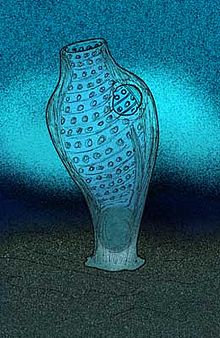Loading AI tools
Extinct genus of animals From Wikipedia, the free encyclopedia
Burykhia hunti is an Ediacaran fossil from the White Sea region of Russia dating to 555 million years ago. It is considered of possibly ascidian affinity, due to the sac-like morphology and a series of distinctly perforated bands reminiscent of a tunicate pharynx. If B. hunti is a tunicate, it could be the oldest ascidian fossil known as of its publication in 2012.[1] It is possibly related to the slightly younger Ausia, another putative ascidian from the Vendian biota in Namibia.[1] In the case of Burykhia, the narrow longitudinal vessels support affinity with the suborder Phlebobranchia.
| Burykhia Temporal range: | |
|---|---|
 | |
| reconstruction as a tunicate-like animal | |
| Scientific classification | |
| Domain: | Eukaryota |
| Kingdom: | Animalia |
| Phylum: | Chordata |
| Subphylum: | Tunicata |
| Class: | Ascidiacea (?) |
| Family: | †Ausiidae |
| Genus: | †Burykhia Fedonkin, Vickers-Rich, Swalla, Trusler & Hall, 2012 |
| Species: | †B. hunti |
| Binomial name | |
| †Burykhia hunti Fedonkin, Vickers-Rich, Swalla, Trusler & Hall, 2012 | |
Seamless Wikipedia browsing. On steroids.
Every time you click a link to Wikipedia, Wiktionary or Wikiquote in your browser's search results, it will show the modern Wikiwand interface.
Wikiwand extension is a five stars, simple, with minimum permission required to keep your browsing private, safe and transparent.